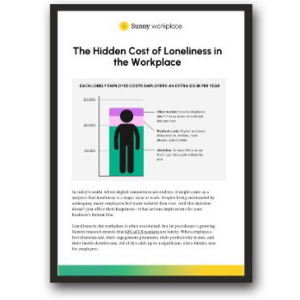
5 ways to boost employee engagement and unlock social well-being
Employee social well-being isn’t just another corporate buzzword—it’s a cornerstone of any thriving organization in today’s workforce.
In hybrid, remote, and traditional environments, social well-being is defined by the quality and quantity of people’s relationships, both personally and professionally. The greater an employee’s social well-being, the greater their likelihood to engage positively in tasks, find job satisfaction, stay with the company, and contribute to its success.
But social well-being extends far beyond water cooler chats and elevator small-talk. It’s about building meaningful connections that make work more fulfilling and collaborative for everyone. As organizations increasingly focus on holistic well-being, emphasizing the value of social connection is key to creating a positive and productive culture. This article explores the impact of social well-being on employee engagement and offers practical strategies to help your team feel more connected and supported.
Why is social well-being important at work?
Social well-being is a vital part of an employee’s overall well-being and has a direct impact on their engagement, productivity, and job satisfaction. When employees have strong social connections at work, they feel more supported, valued, and motivated, which naturally leads to better performance.
Research by Gallup shows that employees with strong social ties at work are seven times more likely to be engaged in their jobs compared to those without such connections. Additionally, workplaces that prioritize social well-being tend to see lower turnover rates, as employees are less likely to leave a company where they feel a deep sense of belonging. This community feeling is not only great for retaining talent but also for fostering a positive, collaborative work culture that benefits everyone.
Social well-being also plays a critical role in mental health. Employees who feel isolated or disconnected are more prone to stress, burnout, and disengagement. In contrast, those with meaningful connections at work are better equipped to handle stress and maintain a healthy work-life balance, while also lowering their likelihood for depression, anxiety, and other chronic conditions that lower quality of life.
By investing in social well-being, organizations can create a work environment where employees feel connected, supported, and engaged, leading to better outcomes for both individuals and the organization as a whole.
5 strategies to enhance employee well-being
To truly boost social well-being in the workplace, it’s important to implement strategies that encourage meaningful connections among employees. Here are five actionable strategies to enhance employee well-being by strengthening social connections:
1. Look for small ways to change the social environment without forcing it
Enhancing social well-being often starts with small, thoughtful changes to the workplace environment that encourage interaction without making employees feel pressured. Simple adjustments like creating open communal spaces, organizing casual meet-ups, or offering flexible seating arrangements can have a big impact.
Encouraging organic interactions is key. For example, providing a cozy break area where employees can gather for coffee or lunch can naturally spark conversations and connections. Additionally, organizing optional social events and implementing social-friendly policies, such as game nights, walking meetings, or after-work gatherings, provides opportunities for employees to bond both during and outside of work hours.
These small, voluntary initiatives can gradually transform the workplace culture, making it more inclusive and connected without imposing forced interactions that might feel inauthentic.
2. Ask the influential people in your organization
To effectively enhance social well-being, it’s important to engage those who naturally influence and connect with others in the organization. Identifying and consulting with these social influencers can provide valuable insights into what might work best for your team.
Influencers in the workplace are often those who are trusted, well-liked, and have a strong network of connections. By asking these individuals how they would approach improving social connection, HR leaders can gain practical ideas that are more likely to resonate with everyone.
For instance, an influencer might suggest informal networking events or peer mentoring programs to help employees feel more connected. Engaging these key individuals not only taps into their social capital but also empowers them to play a pivotal role in fostering a more connected work environment.
3. Engage and support workplace influencers to build social connections
Once you’ve identified the influential people in your organization, the next step is to support and empower them to take action. Providing these individuals with the resources, tools, and encouragement they need to drive social initiatives can significantly boost the social well-being of the entire workplace.
For example, you could create a “social committee” led by these influencers to plan and organize regular events that bring employees together. This committee could also be tasked with welcoming new employees, helping them integrate into the team, and ensuring that everyone feels included in workplace activities.
Supporting influencers in this way not only strengthens social bonds but also helps create a culture of inclusivity where everyone feels they have a role in building a positive workplace environment. It’s important to note that inclusivity is key here. These efforts should be aimed at helping everyone feel included and valued.
4. Leverage technology to foster (more personal) connection in remote and hybrid work environments
Maintaining social connections can be challenging with the rise of remote and hybrid work. However, technology offers powerful tools to bridge the gap and keep employees connected, no matter where they are located.
Using collaboration platforms like Slack, Microsoft Teams, or Zoom can facilitate regular communication and create virtual spaces for social interactions. Virtual coffee breaks, team-building games, or even online interest groups can help remote employees feel more connected to their colleagues.

Additionally, implementing recognition programs and practices that celebrate employees’ contributions and milestones can boost morale and foster a sense of belonging, even in a virtual setting. By leveraging technology effectively, organizations can ensure that social well-being remains a priority, no matter the work environment.
5. Measure the impact of social well-being initiatives
To ensure that your social well-being strategies are effective, it’s important to regularly measure their impact and make adjustments as needed. This can be done through employee surveys, feedback sessions, and by monitoring key metrics like employee engagement scores, turnover rates, and participation in social activities.
By collecting and analyzing this data, visibility is gained into which initiatives are working well and where improvements can be made. For example, if a particular social event had high participation and positive feedback, it could be replicated or expanded upon. Conversely, if employees feel that certain initiatives are forced or unnecessary, adjustments can be made to better align with their preferences.
Measuring the success of social well-being strategies not only helps in fine-tuning them but also shows employees that their well-being is a top priority for the organization.
The power of connection and engagement
All humans crave connection. Investing in social well-being is a crucial step in creating a workplace where everyone feels connected, engaged, and valued.
By implementing strategies that encourage organic interactions, leverage the influence of key individuals, and bridge gaps with technology—and consistently track their effectiveness—organizations can significantly enhance the social connections that drive long-term well-being.
Incorporating these strategies into your employee well-being approach will not only strengthen social connections but also foster a more engaged and productive workforce, laying the foundation for long-term success.


